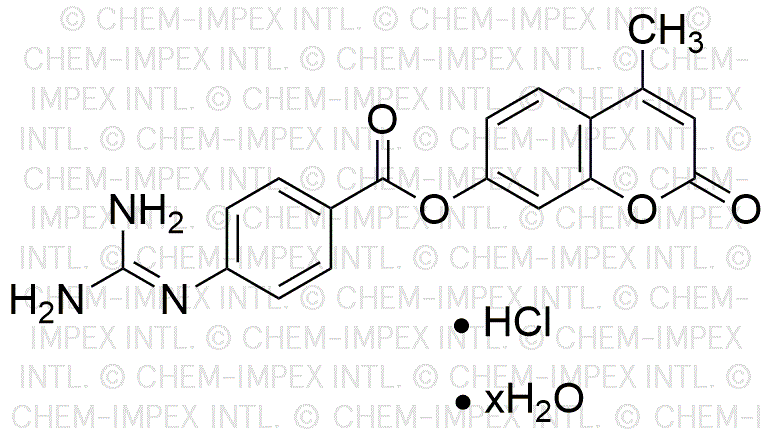4-Methylumbelliferyl 4-guanidinobenzoate hydrochloride hydrate is widely utilized in research focused on:
- Enzyme Activity Assays: This compound is commonly used as a substrate in enzyme assays, particularly for measuring the activity of proteases. Its fluorescent properties allow for easy detection and quantification, making it a valuable tool in biochemical research.
- Cellular Studies: Researchers employ this chemical in cell culture experiments to study cellular processes and signaling pathways. Its ability to penetrate cell membranes enhances its utility in live-cell imaging.
- Drug Development: In pharmaceutical research, it serves as a model compound for developing and testing new drugs, especially those targeting proteolytic enzymes. This aids in identifying potential therapeutic candidates.
- Diagnostics: The compound is also used in diagnostic assays to detect specific enzyme activities related to various diseases, providing insights into disease mechanisms and aiding in early diagnosis.
- Biotechnology Applications: Its role in biotechnological applications includes the development of biosensors that utilize enzyme-substrate interactions, which can be crucial for environmental monitoring and food safety testing.
General Information
Properties
Safety and Regulations
Applications
4-Methylumbelliferyl 4-guanidinobenzoate hydrochloride hydrate is widely utilized in research focused on:
- Enzyme Activity Assays: This compound is commonly used as a substrate in enzyme assays, particularly for measuring the activity of proteases. Its fluorescent properties allow for easy detection and quantification, making it a valuable tool in biochemical research.
- Cellular Studies: Researchers employ this chemical in cell culture experiments to study cellular processes and signaling pathways. Its ability to penetrate cell membranes enhances its utility in live-cell imaging.
- Drug Development: In pharmaceutical research, it serves as a model compound for developing and testing new drugs, especially those targeting proteolytic enzymes. This aids in identifying potential therapeutic candidates.
- Diagnostics: The compound is also used in diagnostic assays to detect specific enzyme activities related to various diseases, providing insights into disease mechanisms and aiding in early diagnosis.
- Biotechnology Applications: Its role in biotechnological applications includes the development of biosensors that utilize enzyme-substrate interactions, which can be crucial for environmental monitoring and food safety testing.
Documents
Safety Data Sheets (SDS)
The SDS provides comprehensive safety information on handling, storage, and disposal of the product.
Product Specification (PS)
The PS provides a comprehensive breakdown of the product’s properties, including chemical composition, physical state, purity, and storage requirements. It also details acceptable quality ranges and the product's intended applications.
Certificates of Analysis (COA)
Search for Certificates of Analysis (COA) by entering the products Lot Number. Lot and Batch Numbers can be found on a product’s label following the words ‘Lot’ or ‘Batch’.
Número de catálogo
Número de lote/lote
Certificates Of Origin (COO)
This COO confirms the country where the product was manufactured, and also details the materials and components used in it and whether it is derived from natural, synthetic, or other specific sources. This certificate may be required for customs, trade, and regulatory compliance.
Número de catálogo
Número de lote/lote
Safety Data Sheets (SDS)
The SDS provides comprehensive safety information on handling, storage, and disposal of the product.
DownloadProduct Specification (PS)
The PS provides a comprehensive breakdown of the product’s properties, including chemical composition, physical state, purity, and storage requirements. It also details acceptable quality ranges and the product's intended applications.
DownloadCertificates of Analysis (COA)
Search for Certificates of Analysis (COA) by entering the products Lot Number. Lot and Batch Numbers can be found on a product’s label following the words ‘Lot’ or ‘Batch’.
Número de catálogo
Número de lote/lote
Certificates Of Origin (COO)
This COO confirms the country where the product was manufactured, and also details the materials and components used in it and whether it is derived from natural, synthetic, or other specific sources. This certificate may be required for customs, trade, and regulatory compliance.


